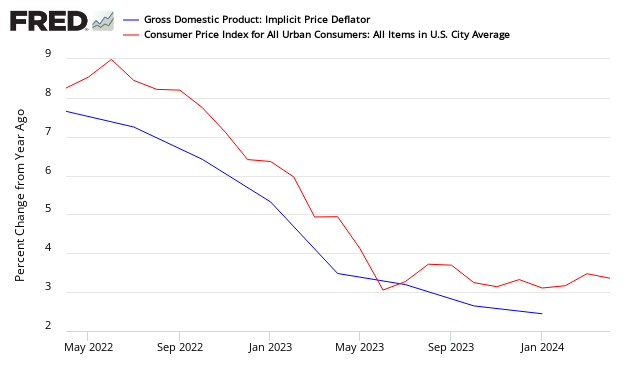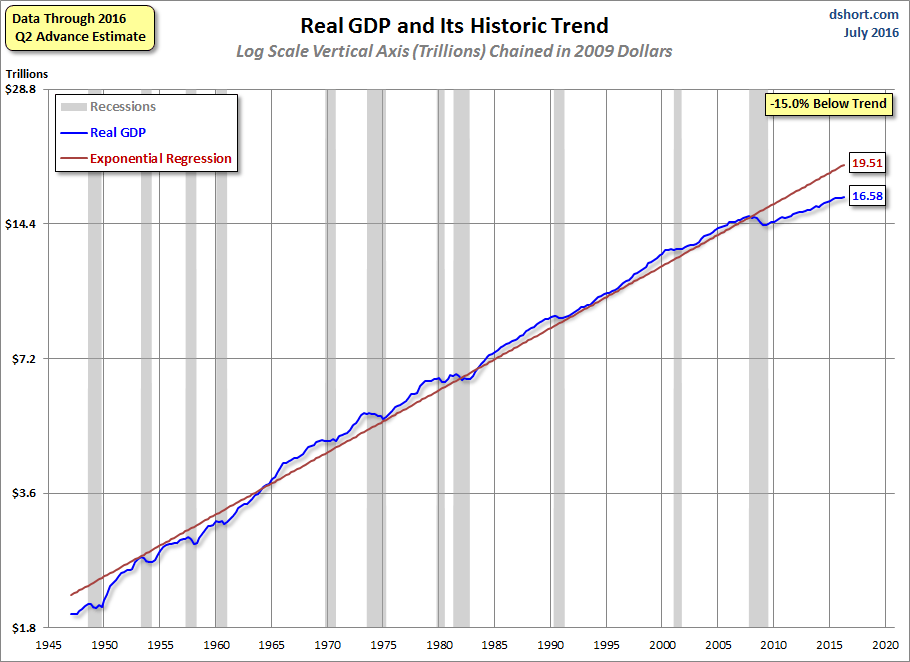Written by Doug Short and Steven Hansen

The second estimate of second quarter 2014 Real Gross Domestic Product (GDP) is now a positive 4.2%.
- The market expected GDP at +3.7% to 4.1% (consensus +4.0%).
- This data point was +4.0% in the advance GDP estimate.
Headline GDP is calculated by annualizing one quarter’s data against the previous quarters data (and the previous quarter was terrible in this instance). A better method would be to look at growth compared to the same quarter one year ago. For 2Q2014, the year-over-year growth is 2.5% – up from 1Q2014’s 1.9% year-over-year growth. So one might say that GDP growth accelerated 0.6% from the first quarter.
If one wants to pick a single reason for the downward revision of GDP between the advance and second estimate – it was due to improvement in the trade balance.
This second estimate released today is based on more complete source data than were available for the “advance” estimate issued last month. (See caveats below.)
Real GDP is inflation adjusted and annualized and per capita GDP has now recovered from the values before the Great Recession.
Real GDP per Capita

The table below compares the 1Q2014 GDP (Table 1.1.2) with the advance and second estimate 2Q2014 GDP which shows:
- consumption for goods and services has improved;
- trade balance again worsened (but improved between the advance and 2nd estimate);
- there was an inventory growth adding almost 1.7% to GDP;
- fixed investment improved;
- government spending actually added to GDP.
The arrows in the table below show the improvement between the advance and second estimate.
[click on graphic below to enlarge]
What the BEA says about the second estimate of 2Q2014 GDP:
The increase in real GDP in the second quarter primarily reflected positive contributions from personal consumption expenditures (PCE), private inventory investment, exports, nonresidential fixed investment, state and local government spending, and residential fixed investment. Imports, which are a subtraction in the calculation of GDP, increased.
Real GDP increased 4.2 percent in the second quarter after decreasing 2.1 percent in the first. This upturn in the percent change in real GDP primarily reflected upturns in exports and in private inventory investment, accelerations in PCE and in nonresidential fixed investment, and upturns in state and local government spending and in residential fixed investment that were partly offset by an acceleration in imports.
Inflation continues to moderate as the “deflator” which adjusts the current value GDP to a “real” comparable value continues to moderate. The market expected the deflator at 2.0% to 2.1% (consensus is 2.0%) versus the reported 2.1%. The following compares the GDP deflator to the Consumer Price Index:

What the BLS says about the revision from the advance to the second estimate:
The upward revision to the percent change in real GDP primarily reflected an upward revision to nonresidential fixed investment and a downward revision to imports that were partly offset by a downward revision to private inventory investment.
In the same release, corporate profits data was released showing expansion in 2Q2014 :
Profits from current production (corporate profits with inventory valuation adjustment (IVA) and capital consumption adjustment (CCAdj)) increased $154.9 billion in the second quarter, in contrast to a decrease of $201.7 billion in the first.
Taxes on corporate income increased $39.7 billion in the second quarter, compared with an increase of $66.9 billion in the first. Profits after tax with IVA and CCAdj increased $115.2 billion, in contrast to a decrease of $268.6 billion.
Dividends decreased $1.3 billion in the second quarter, compared with a decrease of $89.5 billion in the first. Undistributed profits increased $116.5 billion, in contrast to a decrease of $178.9 billion. Net cash flow with IVA — the internal funds available to corporations for investment — increased $130.9 billion, in contrast to a decrease of $163.0 billion. Domestic profits of financial corporations increased $30.6 billion in the second quarter, in contrast to a decrease of $86.2 billion in the first. Domestic profits of nonfinancial corporations increased $119.3 billion, in contrast to a decrease of $89.6 billion.

Overview Analysis:
Here is a look at GDP since Q2 1947 together with the real (inflation-adjusted) S&P Composite. The start date is when the BEA began reporting GDP on a quarterly basis. Prior to 1947, GDP was reported annually. To be more precise, what the lower half of the chart shows is the percent change from the preceding period in Real (inflation-adjusted) Gross Domestic Product. I’ve also included recessions, which are determined by the National Bureau of Economic Research (NBER).

Here is a close-up of GDP alone with a line to illustrate the 3.3 average (arithmetic mean) for the quarterly series since the 1947. I’ve also plotted the 10-year moving average, currently at 1.6 percent, down from 1.7 percent last quarter.

Here is the same chart with a linear regression that illustrates the gradual decline in GDP over this timeframe.

A particularly telling representation of slowing growth in the US economy is the year-over-year rate of change.
And for a bit of political trivia, here is a look at GDP by party in control of the White House and Congress.

In summary, the Q2 GDP Second Estimate of 4.2 percent was well above forecasts and supports the mainstream view that the Q1 GDP contraction was a weather-related fluke.
The chart below is a way to visualize real GDP change since 2007. The chart uses a stacked column chart to segment the four major components of GDP with a dashed line overlay to show the sum of the four, which is real GDP itself. As the analysis clear shows, personal consumption is key factor in GDP mathematics.
Caveats on the Use of Gross Domestic Product (GDP)
GDP is market value of all final goods and services produced within the USA where money is used in the transaction – and it is expressed as an annualized number. GDP = private consumption + gross investment + government spending + (exports − imports), or GDP = C + I + G + (X – M). GDP counts monetary expenditures. It is designed to count value added so that goods are not counted over and over as they move through the manufacture – wholesale – retail chain.
The vernacular relating to the different GDP releases:
“Advance” estimates, based on source data that are incomplete or subject to further revision by the source agency, are released near the end of the first month after the end of the quarter; as more detailed and more comprehensive data become available, “second” and “third” estimates are released near the end of the second and third months, respectively. The “latest” estimates reflect the results of both annual and comprehensive revisions.
Consider that GDP includes the costs of suing your neighbor or McDonald’s for hot coffee spilled in your crotch, plastic surgery or cancer treatment, buying a new aircraft carrier for the military, or even the replacement of your house if it burns down – yet little of these activities is real economic growth.
GDP does not include include home costs (other than the new home purchase price even though mortgaged up the kazoo), interest rates, bank charges, or the money spent buying anything used.
It does not measure wealth, disposable income, or employment.
In short, GDP does not measure the change of the economic environment for Joe Sixpack in 1970, and Joe Sixpack’s kid, yet pundits continuously compare GDP across time periods.
Although there always will be some correlation between all economic pulse points, GDP does not measure the economic elements that directly impact the quality of life of its citizens.
Related Articles
Old Analysis Blog | New Analysis Blog |
| Posts on GDP | Posts on GDP |











